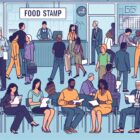Six Tips on Qualifying for Nutrition Assistance Programs

Are you struggling to afford nutritious food? Don’t worry, we’ve got you covered.
In this article, we’ll provide you with six tips on how to qualify for nutrition assistance programs. From understanding income guidelines to gathering required documentation, we’ll walk you through the process step by step.
By following our advice, you’ll be able to access the support you need to nourish yourself and your family.
So let’s get started on your journey towards a healthier, more affordable diet.
Key Takeaways
- Review specific income and asset requirements set by the program
- Gather necessary paperwork for application including proof of identity, residency, and income
- Familiarize yourself with income guidelines set by the program
- Explore special programs catering to specific needs
Determine Eligibility Criteria
To determine your eligibility for nutrition assistance programs, start by reviewing the specific income and asset requirements set by the program. Each program has its own guidelines, so it’s important to understand what they’re before you apply. Generally, these programs are designed to help individuals and families who are struggling financially to access nutritious food.
Income requirements typically take into account factors such as your household size and income level. You may be asked to provide documentation such as pay stubs or tax returns to verify your income. It’s important to note that some programs have income limits, while others have income guidelines that are based on a percentage of the federal poverty level.
Asset requirements refer to the value of your belongings, such as savings accounts, property, or vehicles. Some programs have asset limits, meaning that your total assets can’t exceed a certain amount. However, it’s worth noting that not all programs have asset limits, so it’s important to check the specific requirements of the program you’re interested in.
Gather Required Documentation
Collect the necessary paperwork to apply for nutrition assistance programs. It’s important to gather all the required documentation to ensure a smooth and efficient application process. The specific documents you’ll need may vary depending on the program you’re applying for, but there are some common items that are typically required.
First, you’ll need to provide proof of identity. This can be in the form of a driver’s license, passport, or other government-issued identification document. Make sure that your ID is current and valid.
Next, you’ll need to show proof of residency. This can be done by providing a utility bill, lease agreement, or any other document that shows your current address.
You will also need to provide documentation of your income. This can include pay stubs, tax returns, or any other proof of income you receive. Make sure to include any and all sources of income, including wages, child support, and government assistance.
Additionally, you may be required to provide proof of expenses, such as rent or mortgage payments, utility bills, and medical expenses.
Understand Income Guidelines
To determine your eligibility for nutrition assistance programs, it is important to understand the income guidelines set by the program. These guidelines take into account your household size and income level to determine if you qualify for the program. Here is a table outlining the income limits for some of the most common nutrition assistance programs:
| Program | Household Size | Maximum Monthly Income |
|---|---|---|
| Supplemental Nutrition Assistance Program (SNAP) | 1 | $1,354 |
| 2 | $1,832 | |
| 3 | $2,311 | |
| 4 | $2,790 | |
| Women, Infants, and Children (WIC) | 1 | $1,926 |
| 2 | $2,607 | |
| 3 | $3,289 | |
| 4 | $3,970 | |
| National School Lunch Program | 1 | $1,383 |
| 2 | $1,868 | |
| 3 | $2,353 | |
| 4 | $2,839 |
It is important to note that these income guidelines are subject to change and may vary based on your location and the specific program you are applying for. It is recommended to check the official website or contact the program directly for the most up-to-date information. Understanding the income guidelines will help you determine if you qualify for nutrition assistance programs and allow you to prepare the necessary documentation for your application.
Explore Special Programs for Specific Groups
Learn about the special programs available for specific groups to enhance your understanding of potential nutrition assistance options. These programs are designed to cater to the unique needs of different individuals and communities, ensuring that everyone has access to nutritious food.
- Women, Infants, and Children (WIC): WIC provides nutrition assistance to low-income pregnant women, new mothers, and young children. It offers food vouchers, nutrition education, and support for breastfeeding.
- Senior Farmers’ Market Nutrition Program (SFMNP): SFMNP provides low-income seniors with coupons that can be used to purchase fresh fruits, vegetables, honey, and herbs at farmers’ markets, roadside stands, and community-supported agriculture programs.
- School Breakfast and Lunch Programs: These programs provide free or reduced-price meals to eligible children in schools. They ensure that children have access to nutritious meals during the school day, promoting their health and academic success.
- Summer Food Service Program (SFSP): SFSP offers free meals to children during the summer months when school isn’t in session. It helps bridge the nutrition gap for children who rely on school meals for their daily nutrition.
- Emergency Food Assistance Program (TEFAP): TEFAP provides food assistance to low-income individuals and families in need. It distributes food through food banks, soup kitchens, and other local organizations.
Seek Assistance and Support
You can reach out for assistance and support to navigate the process of qualifying for nutrition assistance programs. Applying for these programs can be overwhelming, but there are resources available to help you through the process.
One option is to contact your local Department of Social Services or Department of Human Services. They can provide guidance and answer any questions you may have.
Additionally, you can seek assistance from nonprofit organizations that specialize in helping individuals and families access nutrition assistance programs. These organizations often have trained staff who can assist with the application process and provide information on available resources.
Another valuable resource is community outreach programs, which can connect you with local agencies that offer nutrition assistance. These programs may also provide educational resources on healthy eating and budgeting.
Frequently Asked Questions
Are There Any Restrictions on the Types of Food That Can Be Purchased With Nutrition Assistance Benefits?
You can buy a variety of food with nutrition assistance benefits. However, there may be restrictions on certain items like alcohol, tobacco, and hot prepared meals. Make sure to check the guidelines for your specific program.
How Long Does the Application Process Typically Take for Nutrition Assistance Programs?
The application process for nutrition assistance programs typically takes several weeks. You will need to complete an application, provide documentation, and attend an interview. Be prepared for a thorough review of your eligibility.
Can I Still Receive Nutrition Assistance if I Am Employed?
You can still receive nutrition assistance if you’re employed. The program takes into account your income and expenses to determine eligibility. Don’t hesitate to apply if you need support to ensure your nutritional needs are met.
Are There Any Penalties for Providing False Information on the Application for Nutrition Assistance Programs?
Yes, there are penalties for providing false information on the application for nutrition assistance programs. It is important to be honest and accurate when filling out the application to avoid legal consequences.
Can I Apply for Nutrition Assistance Programs if I Am Not a US Citizen?
Yes, you can apply for nutrition assistance programs even if you’re not a US citizen. The program is open to legal immigrants and certain non-citizens who meet the eligibility criteria.



